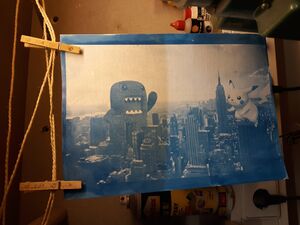Cyanotype
Cyanotype is a printing process that involves chemically treating a medium with photosensitive chemicals which, when exposed to UV light (e.g. the sun) react to deposit prussian blue pigment on the medium.
Drew's kit
ddevault has purchased a Cyanotype kit which is in the dirty room. Since this involves the use of hazardous chemicals, please speak to Drew before messing with it.
Have:
- Ferric amonium oxalate solution
- Citric acid
- Heavy-duty art paper which can take a few washings
- Laserprint-compatible transparencies
- Sponge applicator brush and a suitable syringe
- A plexiglass applicator rod
- PPE (chemical respirator mask & disposable gloves)
Needs/wants:
- A glass applicator rod
- A better washing tray
- A better drying solution
- More PPE so others can get involved
- To convince the printer to print in better quality on my transparencies
- More sunlight in this bloody swamp country
Maybes:
- UV light source for the dirty room
- Toning supplies
Lessons learned
I have wasted a lot of chemicals fucking up, so maybe you can learn from me.
- Access to good quality direct sunlight is very important. Indirect sunlight (bouncing off of the walls of ACTA, for instance) or covered up too frequently by clouds and the print quality will suffer a lot.
- Evenly spreading the solution over the page is *very* important. The sponge brush approach is garbage. I have a plexiglass rod which is much better, but I would prefer a glass rod at some point. I spread about 2 mL of solution for an A4 paper with a syringe, then use the glass rod to evenly spread it over the whole page. I am careful to use a paper towel to clean up any loose solution on the board, especially if the paper is resting in it - anywhere the solution soaks all the way through will come out badly.
- Use a very light flow from the sink to wash the print, but use enough to get a laminar flow so it runs evenly over the page. A heavier flow will wash off the pigments during the first washing.
- Let it dry completely before exposing it or you'll ruin your transparencies.
